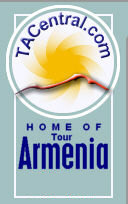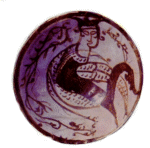At last! A guide to the History Museum on Republic Square! If you hadn't yet noticed, Armenia's greatest treasures were recurated in 2001, and they threw out the translations with the Communist artifacts. We've come to the rescue with the first Guide to the Museum, in English. Feel free to open the PDF file at the bottom of this page and print it out for yourself, or distribute to others.
The State History Museum, Republic Square, Tel: 58-27-61, 56-58-12, is in the same building as the National Art Gallery, occupying the first (ground) and second (next) floors.
Its collection covers Armenia’s history from 250,000 BCE to the 20th century. The museum has some incredible items on display, though the best artifacts were shipped to the Hermitage Museum in St. Petersburg during Communist times. Unlike other world museums, which protect their items behind barriers, the State History Museum has exhibited most artifacts within reach (dangerously so for the priceless Bronze Age vessels, some of which are without peer).
Unfortunately the collection is at times a mish-mash of items from different eras, without explanation or context: in some rooms the displays appear to have been assembled by a fashion designer rather than an historian. Upstairs there is a sense of context, but downstairs artifacts are displayed hodgepodge, with 19th c domestic carpets next to 4000 BCE ritual vessels. The museums at Metsamor, Erebuni and Sardarabat, though in poor physical condition, are infinitely more illustrative of their history, with more knowledgeable staff.
And unless you are fluent in Armenian, you are out of luck: the curators haven’t got around to translating placards into foreign languages, despite a rich Armenian gave a fortune to renovate the museum and re-curate the collection into a “world-class” exhibit. Other than dusting the floor and changing a few light bulbs, one wonders where all the money went. Not into translations! Save a few poorly translated placards in the Burial and L’chashen rooms, you are on your own, to learn Armenian in a hurry or wander around in confusion. The museum provides no maps and no multi-language brochures.
The collection is a must see, but save your visit until the end of your trip, when what you see may make better sense as you put things into perspective with the places you have been.
Click here to open the Guide in PDF format (1.7 mb).




